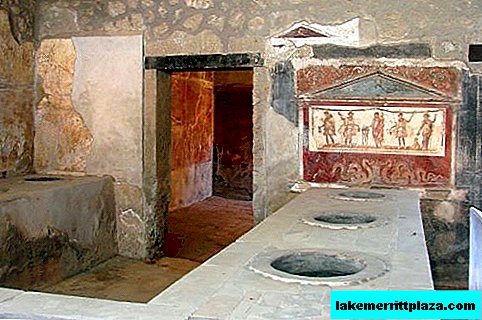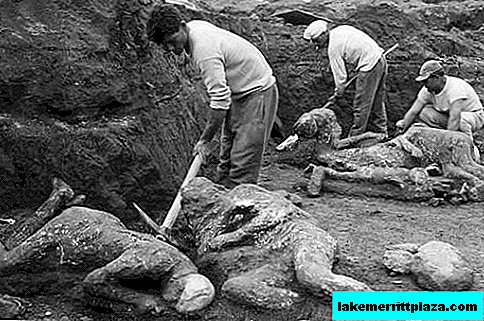Pompeii is one of the most popular archaeological sites in southern Italy. Every year, millions of tourists from all over the world come to see the ancient city, completely covered with ashes during the eruption of Vesuvius. From this article you will learn the history of the city and its tragedy, what makes Pompeii so remarkable, as well as how to get here by public transport and through regular excursions.
The fertile lands on the slopes and around Vesuvius have long been one of the tidbits on the Apennine peninsula - the first permanent settlements in these places were founded by the Avzon tribe almost 3,000 years ago.
In the VI century. BC. here came the tribe of the Oscans. In place of 5 small settlements, Pompeii appeared (from the Oscan pompe - “five”).
However, there is another version of the origin of this name, which is associated with the name of Hercules.

Many residential buildings in Pompeii were decorated at the highest artistic level.
According to legend, the greatest ancient hero made his triumph in these places after defeating the giant Gerion. Then he founded Pompeii (from the ancient Greek pompe - solemn procession) and Herculaneum ("the city of Hercules").
Pompeii in its heyday
By the 6th century BC The construction of the first fortress wall and the most ancient sanctuary, the Temple of Apollo, also apply. In the V century. BC. the territory passed to the Samnites - one of the peoples of ancient Italy, who constantly fought with Rome.
In 310 BC Pompeii became allies of Rome as a free city, however, opposing it in 89 BC, they lost their independence, becoming one of the colonies.
Rich lands and a surprisingly mild climate very soon attracted the attention of patrician families: the villas outside the ramparts began to appear like mushrooms after the rain.

Villa Mystery got its name from the frescoes depicting Dionysian rituals.
The city through which the Appian Way, connecting Rome and the southern part of the peninsula, also became an influential provincial center.
The huge forum (157 × 38 m) could accommodate almost all the inhabitants (about 20,000 people). As, however, is the amphitheater, where spectacular fights and persecution of wild animals were held. The city also had 2 theaters: the Bolshoi for 5,000 spectators and the Odeon, which accommodated 1,500 people.
Public buildings, numerous temples (Jupiter, Apollo, Isis, Fortune of Augustus) and residential buildings were decorated with statues, frescoes, mosaics, created at the highest artistic level.

Even quite prosperous citizens easily managed without a kitchen in the house
There was also a craft on the rise: Pompeii was famous for the production of woolen fabrics. The townspeople, even quite prosperous, were free to do without a kitchen in the house: hot food was delivered directly to the house from thermopolies (tavern).
The streets were paved with tiles and cobblestones, the sewer and water supply system, the Stabiev terms (for all comers), the forum terms (for honored guests of the city) and suburban baths worked. Pompeii entered a time of economic and cultural prosperity ...
The eruption of Vesuvius and the death of the city
Mid 1st century new era. For one and a half thousand years, Vesuvius did not show excessive activity. Small eruptions, of course, did occur, but even meticulous Roman chroniclers did not attach importance to them.
The first powerful “bell” was the earthquake on February 5, 62. Most of the buildings were destroyed, the surviving residents fled in panic to the surrounding villages, many patricians were completely ruined, becoming dependent on their former slaves, who became usurers.

August 24, 79 the eruption of Vesuvius completely destroyed Pompeii
The city suddenly fell into decay. Recovery was slow: the city treasury was empty. But soon the wealthy artisans, who arranged stupas in the dilapidated buildings, began to pay taxes regularly, and life began to boil again in Pompeii.
From the beginning of the year 79, tremors began to shake again around the city. By August 20, animals and birds disappeared from the forests, and domestic animals were worried. Insightful citizens began to leave their homes.
In the early morning of August 24 a dark cloud appeared over the vent of Vesuvius, the city began to be covered with ashes, and at about one in the afternoon a pillar of fire burst from the crater of the volcano to a height of 20 km, destroying the top of the mountain. The wind changed abruptly - a dark cloud of ash and stone covered Pompeii ...

Under the piles of stones and ash, buildings were destroyed, forever burying those who did not have time to leave the city in time
"Black rain" rained over the city until night. Under piles of stones and ash, buildings were destroyed, forever burying those who tried to hide in the basements and those who could not reach the ghostly refuge.
After midnight, Vesuvius brought a new misfortune. Lava flows erupted from his vent and moved towards Herculaneum, and a red-hot cloud of stench volcanic gas strangled and incinerated all the little living things in the area.
By 8 a.m. on August 25, 79, everything was over, and that the fire had not burned, it was completely washed off by a shower and mud streams.
Pompeii after the eruption
The commission of inquiry from Rome came to the conclusion that the city was completely destroyed, and that how to get to Pompeii along the Appian Way, soon no one spoke.
For many centuries, the surroundings of Vesuvius turned into lifeless gray plains with frozen pieces of lava. After a thousand years, these plains turned green again, and people who knew nothing of the ancient tragedy returned to the slopes of the volcano.
At the end of the XVI century. when digging canals, fragments of the wall were discovered, a century later - the remains of mosaics and several inscriptions. Full excavations began a hundred years later - in 1748.

In the basement of the villa of Diomedes, archaeologists discovered the remains of 20 dead during the eruption of Vesuvius
It was assumed that the ruins found were related to the city of Stabia. And only in 1763 was a border post found, the inscriptions on which indicated that this city was Pompeii.
To date, excursions to Pompeii can be seen up to ¾ of the ancient city. The remaining areas due to frequent earthquakes have not yet been investigated. The best preserved arena, large palestra, theaters, thermae, suburban lupanarium with famous frescoes on frivolous themes, as well as part of residential buildings and villas.
From that on what to see in Pompeii and the surrounding area is definitely worth it - Villa Mystery, located behind the ruins of the Gate of Herculaneus, named after the frescoes depicting Dionysian rituals, and Villa Diomedes. It was in her basement that the remains of 20 dead during the eruption of Vesuvius were discovered.

The interior walls of buildings in Pompeii are decorated with frescoes and mosaics.
The internal walls of the buildings are decorated with frescoes and mosaics, illustrating both legends and ritual performances, as well as the lives of ordinary citizens.
A lot of images of animals, fish and birds. Once these "pictures" replaced the inhabitants of Pompeii with wallpaper and tapestries, which is why they are found in almost every house.
Most of them are replaced by copies. The scripts were relocated to the National Archaeological Museum of Naples. The most famous mosaics are Pompeian Cat, Battle of Alexander at Issus, Plato's Academy, Comedians.
How to get to Pompeii
Solve a problem, how to get to Pompeii, you can still at home, but you can also on arrival in Rome or Naples, from which the ancient city is only 28 km.
The most convenient and fastest way is to travel by rail. Trains from Rome to Naples run 1-2 times per hour, and the trip will take only 1-2 hours, depending on the selected train.
Since the Rome-Naples route is in high demand year-round, it makes sense to buy train tickets in advance - online. The easiest way to do this is on the Omio website.
To do this, you only need to know the exact date of the trip and have a bank card on hand. The ticket itself after payment will come to you by e-mail. In more detail about all the ways to make this trip, BlogoItaliano wrote in the article How to get from Rome to Naples and from Naples to Rome.

Look at the ancient city millions of tourists come annually
Once in Naples, you need to transfer to the Circumvesuviana train, next to Sorrento from the central station, in Piazza Garibaldi (Napoli Garibaldi station). Electric trains run every half hour from early morning to late evening.
Exit at Pompei Scavi / Villa Misteri Station. Journey time - from 20 to 35 minutes (depends on whether the train goes with all the stops or not). From the station to the excavations and entrance of Porta Marina - only a few hundred meters. We wrote more about the route here: How to independently visit Pompeii and Herculaneum from Naples in 1 day.
Another option to get to Pompeii from Rome is to transfer to Salerno. Although at first this route does not seem to be the most successful, because you have to make a hook, it may turn out to be faster than the previous one in time.
The fact is that all trains from Rome to Naples arrive at the central train station of Naples, and trains to Pompeii depart from the train station on Piazza Garibaldi, where you still need to get there, spending precious time.
When traveling through Salerno, you do not need to change the station. You will have to make only 1 transplant. See all possible travel options here. It is enough to enter the start and end points of the route, as well as indicate a convenient date and number of travelers.
Tickets and opening hours
The price of a ticket to Pompeii itself is € 15 (2019). A ticket to visit 3 archaeological sites (Pompeii, Oplontis, Boscoreale), valid for 3 days, will cost a little more - only € 18 (2019).
From April 1 to October 31, you can stroll through the ancient cities from 8:30 to 19:30 (entrance is open until 18:00), from November 1 to March 31 - from 8:30 to 17:00 (entrance is open until 15:30 )
Excursions to Pompeii from Naples and Amalfi
In Naples there are a lot of Russian-speaking guides who will be happy to show you Pompeii. The only thing is that it is better to agree with them in advance, since in the season the dates of many excursions are busy even several months in advance.
A detailed description, prices and reviews of the most popular excursions can be found on the links below.
Excursions to Pompeii from Rome
Pompeii (combined in one excursion with Naples) is in incredible demand at any time of the year and is in the TOP of the most popular day trips from Rome. Only Florence can make a worthy competition to Pompeii, but it was more fortunate for it with railway connections.
Due to the fact that there are many trains to Florence, and the road itself takes only an hour and a half, many tourists prefer to make this voyage on their own - without travel agencies. BlogoItaliano wrote more about this here: How to get from Rome to Florence and from Florence to Rome.

To date, excursions to Pompeii can be seen up to ¾ of the ancient city
But we were a little distracted. Most of the regular excursions from Rome to Naples and Pompeii are designed for an English-speaking tourist. Russian-speaking excursions are much smaller, but they are also available.
You can book an excursion from Rome to Naples and Pompeii through our guide in the Eternal City - Lelu (I wrote about BlogoItaliano in detail here), especially since this trip for one day is relatively inexpensive.
Since the prices for the excursion vary depending on the season, it is better to check the actual cost with Lela herself by writing to her by e-mail email protected, or by poisoning the request through the feedback form below.
The only thing that Lele write is better in advance. Since sightseeing groups in Russian excursions to Pompeii formed in advance, then at the peak of the season when booking at the last moment, they simply may not have a place.
Mail to Lela
Have a good trip!
* By clicking on the "Send message to Lele" button, I consent to the processing of personal data and agree to the privacy policy
Photos by: darkrome.com, glogster.com, nature.ca, bestworldstuff.blogspot.com, charmingasiatours.com, panoramio.com, tours-italy.com, rome101.com, lsa.umich.edu, travelthruhistory.tv.








